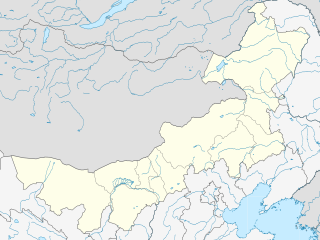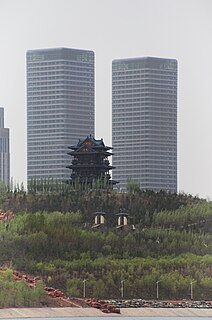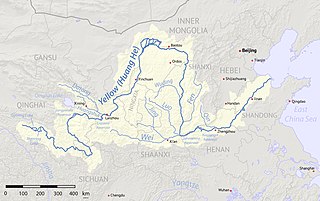The Mongols are a Mongolic ethnic group native to Mongolia and to China's Inner Mongolia Autonomous Region. They also live as minorities in other regions of China, as well as in Russia. Mongolian people belonging to the Buryat and Kalmyk subgroups live predominantly in the Russian federal subjects of Buryatia and Kalmykia.

Inner Mongolia or Nei Mongol, officially the Inner Mongolia Autonomous Region or Nei Mongol Autonomous Region (NMAR), is a Mongolic autonomous region in Northern China. Its border includes most of the length of China's border with Mongolia. The rest of the Sino–Mongolian border coincides with part of the international border of the Xinjiang autonomous region and the entirety of the international border of Gansu province and a small section of China's border with Russia. Its capital is Hohhot; other major cities include Baotou, Chifeng and Ordos.

Suiyuan was a historical province of China. Suiyuan's capital was Guisui. The abbreviation was 綏. The area Suiyuan covered is approximated today by the prefecture-level cities of Hohhot, Baotou, Wuhai, Ordos, Bayan Nur, and parts of Ulaan Chab, all today part of Inner Mongolia Autonomous Region. Suiyuan was named after a district in the capital established in the Qing Dynasty.

The Ordos Desert, also known as the Muu-us or Bad Water Desert, is a desert and steppe region lying on a plateau in the south of the Inner Mongolian Autonomous Region of the People's Republic of China. The soil of the Ordos is a mixture of clay and sand and, as a result, is poorly suited for agriculture. It extends over an area of approximately 90,650 km2 (35,000 sq mi). It comprises two large deserts: the 7th largest desert in China, the Kubuqi Desert in the north, and the 8th largest desert in China, the Muu-us Desert, in the south.

Chinese Mongols are citizens of China who are ethnic Mongols. They form one of the 55 ethnic minorities officially recognized by the People's Republic of China. There are approximately 5.8 million people classified as ethnic Mongols living in China. Most of them live in Inner Mongolia, Northeast China, Xinjiang, etc. The Mongol population in China is over twice that of the sovereign state of Mongolia.

Dongsheng District is a District and the seat of Ordos City, Inner Mongolia, People's Republic of China. It has a district population of 230,579, with 162,317 in the urban area. The district is predominantly Han Chinese, but has a significant Mongol minority.

The Ordos culture was a culture occupying a region centered on the Ordos Loop during the Bronze and early Iron Age from the 6th to 2nd centuries BCE. The Ordos culture is known for significant finds of Scythian art and is thought to represent the easternmost extension of Indo-European Eurasian nomads, such as the Saka. Under the Qin and Han dynasties, from the 6th to 2nd centuries BCE, the area came under at least nominal control of contemporaneous Chinese states.

Bayannur or Bayannao'er is a prefecture-level city in western Inner Mongolia, People's Republic of China. Until December 1, 2003, the area was called Bayannur League.
The Southern Mongolian Democratic Alliance was created in May 1992, by Hada and other Mongol activists including Tegexi. Its major goal is the self-determination of Inner Mongolia.
Ordos Mongolian is a variety of Central Mongolic spoken in the Ordos City region in Inner Mongolia and historically by Ordos Mongols. It is alternatively classified as a language within the Mongolic language family or as a dialect of the Central Mongolian Mongolian standard language. Due to the research of Antoine Mostaert, the development of this dialect can be traced back 100 years.
The Upper Mongols, also known as the Köke Nuur Mongols or Qinghai Mongols, are ethnic Mongol people of Oirat and Khalkha origin who settled around Qinghai Lake in so-called Upper Mongolia. As part of the Khoshut Khanate of Tsaidam and the Koke Nuur they played a major role in Sino–Mongol–Tibetan politics during the 17th and 18th centuries. The Upper Mongols adopted Tibetan dress and jewelry despite still living in the traditional Mongolian ger and writing in the script.

Togtoh County is a county of Inner Mongolia Autonomous Region, North China, it is under the administration of the prefecture-level city of Hohhot, the capital of Inner Mongolia, located on the north bank of the Yellow River at which point that great river turns out of the Ordos Loop toward the south. It is under the administration of the regional capital of Hohhot, 78 kilometres (48 mi) to the northeast, with a population of around 200,000.

The Ordos are a Mongol subgroup that live in Uushin district, Inner Mongolia of China. Ordos literally means plural of Ordo.
Christians are a minority in Inner Mongolia region of the People's Republic of China. There are Orthodox Churches in Labdarin, Manzhou and Hailar. The Shouters are active in Inner Mongolia. About 100,000 Chinese Christians were in the region in 1993. The region has few Mongolian Christians. Numerous house church leaders were detained in Xilinhot in 2008. Inner Mongolia is an area of rapid growth of Protestantism. Religious Affairs Bureau staff have declared a Christmas gathering in Duolun County illegal in 2006. Inner Mongolia Bible School was founded in 1987. Inner Mongolia has more than 170,000 Protestants and over 1,000 official churches. Tongsun Street Church was started with the help of Swedish missionaries around 1900. According to Tjalling Halbertsma, Christians used to live in Inner Mongolia before 1206. Hohhot used to have or has a very large house church with more than 1500 church members. Protestantism entered the region in the late 19th century. Due to the Dungan Revolt (1895–96) the western Inner Mongolian Han Chinese Catholic village Xiaoqiaopan had defensive procedures institted by the Belgian Priests in charge. Missionaries were killed during the Boxer Rebellion in 1900. The French Catholic vicar apostolic, Msgr. Alfons Bermyn wanted foreign troops garrisoned in inner Mongolia, but the Governor refused. Bermyn petitioned the Manchu Enming to send troops to Hetao where Prince Duan's Mongol troops and General Dong Fuxiang's Muslim troops allegedly threatened Catholics. It turned out that Bermyn had created the incident as a hoax. In Fengzhen, a church was founded as early as 1892. Most Christians in Inner Mongolia are Han Chinese.

Altanochir (1882–1949) was an Inner Mongolian prince, politician, and general under the Republic of China and Mengjiang governments. He served as deputy head of Yeke-juu League. An ethnic Mongol, he was a native of Right-Wing Rear Banner, Ordos.

Mongolian shamanism, more broadly called the Mongolian folk religion, or occasionally Tengerism, refers to the animistic and shamanic ethnic religion that has been practiced in Mongolia and its surrounding areas at least since the age of recorded history. The Mongolian endonym is Böö mörgöl. In the earliest known stages it was intricately tied to all other aspects of social life and to the tribal organization of Mongolian society. Along the way, it has become influenced by and mingled with Buddhism. During the socialist years of the twentieth century it was heavily repressed and has since made a comeback.

Religion in Inner Mongolia is characterised by the diverse traditions of Mongolian-Tibetan Buddhism, Chinese Buddhism, the Chinese traditional religion including the traditional Chinese ancestral religion, Taoism, Confucianism and folk religious sects, and the Mongolian native religion. The region is inhabited by a majority of Han Chinese and a substantial minority of Southern Mongols, so that some religions follow ethnic lines.















